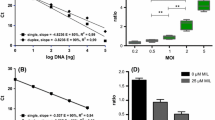Abstract
Fluorescent in situ hybridization coupled with immunofluorescence (FISH/IF) is an assay that has been widely used to study DNA-protein interactions. The technique is based on the use of a fluorescent nucleic acid probe and fluorescent antibodies to reveal the localization of a DNA sequence and a specific protein in the cell. The interaction can be inferred by the quantification of the co-localization between the protein and the DNA. Here, we describe a detailed FISH/IF methodology that our group used to study RPA-telomere interaction in the pathogenic protozoa parasite Trypanosoma cruzi.
Access this chapter
Tax calculation will be finalised at checkout
Purchases are for personal use only
Similar content being viewed by others
References
Odell ID, Cook D (2013) Immunofluorescence techniques. J Invest Dermatol 133(1):e4
Kobayashi T, Tada S, Tsuyama T, Murofushi H, Seki M, Enomoto T (2002) Focus-formation of replication protein A, activation of checkpoint system and DNA repair synthesis induced by DNA double-strand breaks in Xenopus egg extract. J Cell Sci 115:3159–3169
Pavani RS, da Silva MS, Fernandes CAH, Morini FS, Araujo CB, Fontes MR de M, Sant’Anna OA, Machado CR, Cano MI, Fragoso SP, Elias MC (2016) Replication protein A presents canonical functions and is also involved in the differentiation capacity of Trypanosoma cruzi. PLoS Negl Trop Dis 10:e0005181
Croft LV, Ashton NW, Paquet N, Bolderson E, O’Byrne KJ, Richard DJ (2017) hSSB1 associates with and promotes stability of the BLM helicase. BMC Mol Biol 18:1–10
Liu J-S, Kuo S-R, Melendy T (2006) DNA damage-induced RPA focalization is independent of γ-H2AX and RPA hyper-phosphorylation. J Cell Biochem 99:1452–1462
Chen H, Lisby M, Symington LS (2013) RPA coordinates DNA end resection and prevents formation of DNA hairpins. Mol Cell 50:589–600
Lisby M, Rothstein R (2009) Choreography of recombination proteins during the DNA damage response. DNA Repair (Amst) 8:1068–1076
Pavani RS, Lima LP, Lima AA, Fernandes CAH, Fragoso SP, Calderano SG, Elias MC (2020) Nuclear export of replication protein A in the nonreplicative infective forms of Trypanosoma cruzi. FEBS Lett 594:1596–1607
Huber D, Voith von Voithenberg L, Kaigala GV (2018) Fluorescence in situ hybridization (FISH): history, limitations and what to expect from micro-scale FISH? Micro Nano Eng 1:15–24
Volpi EV, Bridger JM (2008) FISH glossary: an overview of the fluorescence in situ hybridization technique. BioTechniques 45:385–409
Cui C, Shu W, Li P (2016) Fluorescence in situ hybridization: cell-based genetic diagnostic and research applications. Front Cell Dev Biol 4:89
Pavani RS, Vitarelli MO, Fernandes CAH, Mattioli FF, Morone M, Menezes MC, Fontes MRM, Cano MIN, Elias MC (2018) Replication protein A-1 has a preference for the telomeric G-rich sequence in Trypanosoma cruzi. J Eukaryot Microbiol 65:345–356
Contreras VT, Araujo-Jorge TC, Bonaldo MC, Thomaz N, Barbosa HS, Meirelles M de N, Goldenberg S (1988) Biological aspects of the Dm 28c clone of Trypanosoma cruzi after metacyclogenesis in chemically defined media. Memórias do Inst. Oswaldo Cruz 83:123–133
Damasceno JD, Nunes VS, Tosi LRO (2013) LmHus1 is required for the DNA damage response in Leishmania major and forms a complex with an unusual Rad9 homologue. Mol Microbiol 90:1074–1087
Bolte S, Cordelières FP (2006) A guided tour into subcellular colocalization analysis in light microscopy. J Microsc 224:213–232
Elias MCQB, Faria M, Mortara RA, Motta MCM, de Souza W, Thiry M, Schenkman S (2002) Chromosome localization changes in the Trypanosoma cruzi nucleus. Eukaryot Cell 1:944–953
Acknowledgments
The authors want to thank Simone Calderano for helping with the photos presented in Fig. 1. M.C.E. is a fellow from the National Council for Scientific and Technological Development (CNPq: 306199/2018-1). RSP received a Fundação de Amparo à Pesquisa do Estado de São Paulo fellowship (FAPESP 2014/02978-0).
Author information
Authors and Affiliations
Corresponding author
Editor information
Editors and Affiliations
Rights and permissions
Copyright information
© 2021 Springer Science+Business Media, LLC, part of Springer Nature
About this protocol
Cite this protocol
Pavani, R.S., Elias, M.C. (2021). Following Trypanosoma cruzi RPA-DNA Interaction Using Fluorescent In Situ Hybridization Coupled with Immunofluorescence (FISH/IF). In: Oliveira, M.T. (eds) Single Stranded DNA Binding Proteins. Methods in Molecular Biology, vol 2281. Humana, New York, NY. https://doi.org/10.1007/978-1-0716-1290-3_12
Download citation
DOI: https://doi.org/10.1007/978-1-0716-1290-3_12
Published:
Publisher Name: Humana, New York, NY
Print ISBN: 978-1-0716-1289-7
Online ISBN: 978-1-0716-1290-3
eBook Packages: Springer Protocols




